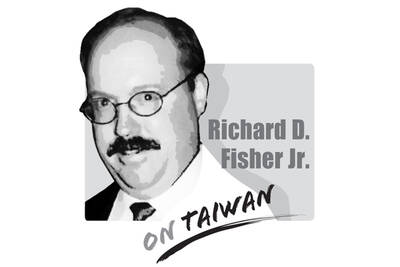If Taiwan needs a sign that the relationship with the US is “at a high water mark,” it only needs to look at the schedule of newly appointed American Institute in Taiwan (AIT) Director Sandra Oudkirk for the past four months.
After assuming the post at the end of July, Oudkirk met with President Tsai Ing-wen (蔡英文) on Aug. 10, when Oudkirk said that “the Taiwan-US relationship is at a high water mark.”
Since then, Oudkirk has kept a packed agenda. From appearing at Taiwan Taoyuan International Airport when Moderna COVID-19 vaccines donated by the US arrived, to traveling to Chiayi County to witness the upgrading of F-16 combat squadrons, to accompanying US congressional delegations to meetings with Tsai and visiting Taiwan Semiconductor Manufacturing Co (TSMC) facilities, there is no question that Oudkirk has been demonstrating the high water mark occasion with tangible actions.
The Global Cooperation and Training Framework (GCTF) is another example.
To resolve the predicaments Taiwan faces in joining international organizations, the US founded the GCTF in 2015, a tailor-made platform to utilize Taiwan’s strengths and expertise to address global issues of mutual concern with the international community, focusing on public health, crime, digital economics, cybersecurity and other fields.
Since assuming her position, Oudkirk has hosted six consecutive workshops with one to two events per month. The topics have included green energy and sustainability, labor rights protection, crisis management and disaster response, women in government, protecting the rights of people with disabilities and countering fake news.
All of these issues are within Taiwan’s areas of expertise, and by standing shoulder to shoulder with the US, the nation can bring to life its slogan of “Taiwan can help” and contribute in a variety of ways to the international community.
Japan became the GCTF’s third partner in 2019, and has since joined Taiwan and the US in cohosting all of its workshops.
Australia also joined the framework in October.
The GCTF alliance can assist Taiwan in becoming central to those countries’ strategies in the Indo-Pacific region.
Additional like-minded countries such as Canada, the UK, Sweden, the Netherlands, Slovakia, Israel and some countries in the EU have joined the GCTF to cohost workshops on a wide range of topics.
Taiwan might be seeing a spillover effect from the GCTF, with a growing number of participating countries and increasing diversity in the topics it covers.
Since the administration of US President Joe Biden took office in January, US Navy vessels have sailed through the Taiwan Strait 11 times, conducting regular freedom of navigation patrols every month. Tsai has also confirmed the presence of US troops in the nation to help train the Taiwanese military.
Meanwhile, a TSMC 5-nanometer wafer plant under construction in Phoenix, Arizona, is to be the US’ largest direct foreign investment in the country’s history.
With defense and supply chain cooperation in place, there is no doubt that the relationship between Taiwan and the US is at a high water mark.
As visits from US government officials and congressional delegations are expected to increase, Oudkirk’s schedule is likely to become busier than ever.
Chen Yung-chang is a company manager.
Translated by Rita Wang
On Sunday, 13 new urgent care centers (UCC) officially began operations across the six special municipalities. The purpose of the centers — which are open from 8am to midnight on Sundays and national holidays — is to reduce congestion in hospital emergency rooms, especially during the nine-day Lunar New Year holiday next year. It remains to be seen how effective these centers would be. For one, it is difficult for people to judge for themselves whether their condition warrants visiting a major hospital or a UCC — long-term public education and health promotions are necessary. Second, many emergency departments acknowledge

Victory in conflict requires mastery of two “balances”: First, the balance of power, and second, the balance of error, or making sure that you do not make the most mistakes, thus helping your enemy’s victory. The Chinese Communist Party (CCP) has made a decisive and potentially fatal error by making an enemy of the Jewish Nation, centered today in the State of Israel but historically one of the great civilizations extending back at least 3,000 years. Mind you, no Israeli leader has ever publicly declared that “China is our enemy,” but on October 28, 2025, self-described Chinese People’s Armed Police (PAP) propaganda
US President Donald Trump’s seemingly throwaway “Taiwan is Taiwan” statement has been appearing in headlines all over the media. Although it appears to have been made in passing, the comment nevertheless reveals something about Trump’s views and his understanding of Taiwan’s situation. In line with the Taiwan Relations Act, the US and Taiwan enjoy unofficial, but close economic, cultural and national defense ties. They lack official diplomatic relations, but maintain a partnership based on shared democratic values and strategic alignment. Excluding China, Taiwan maintains a level of diplomatic relations, official or otherwise, with many nations worldwide. It can be said that
Lockheed Martin on Tuesday responded to concerns over delayed shipments of F-16V Block 70 jets, saying it had added extra shifts on its production lines to accelerate progress. The Ministry of National Defense on Monday said that delivery of all 66 F-16V Block 70 jets — originally expected by the end of next year — would be pushed back due to production line relocations and global supply chain disruptions. Minister of National Defense Wellington Koo (顧立雄) said that Taiwan and the US are working to resolve the delays, adding that 50 of the aircraft are in production, with 10 scheduled for flight